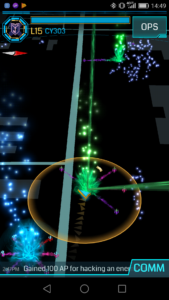This content was originally published by the Longmont Observer and is licensed under a Creative Commons license.
I used to wonder why it would take my husband over an hour to return from a 15-minute trip to the grocery store. Now I know. He was playing Ingress. Ingress could be thought of as a grown-up version of Pokémon Go or a version of a “capture the flag” type of game. In fact, it was around before Pokémon Go was, and Pokegyms are based on portals in Ingress. It is a free game for your cell phone from Niantic and it has a large following worldwide. Ingress is a terrific way to meet new people and explore your town.
There is a backstory to Ingress, but it isn’t necessary to know it to play the game. The story goes that a new type of matter, called exotic matter, was discovered during an experiment at CERN. CERN is the European Organization for Nuclear Research. Exotic matter, or XM as it is known in the game, seemed to be transmitting some kind of information. The question remains whether that information is coming from an alien race. The US government started a top-secret project to study XM. As part of this project, phones were turned into XM scanners to collect XM which researchers then study.

A group of people are alarmed at the implications of XM, believing that an alien race, known as the Shapers, as trying to take over humanity. They are called the Resistance and in the game, they are the depicted by the color blue. Another faction believes that Shapers are trying to help humanity evolve to the next level. In the game, they are depicted by the color green and are known as the Enlightened.
Players try to capture portals in the game. Portals are located where there is art in public places, historic markers, parks, and churches. Players capture portals by deploying resonators on portals that are unclaimed. Unclaimed portals appear grey in the game. If the portal is owned by the opposing faction, players must fire bursters at the portal to take it down. Portals are able to fire back at players, causing them damage. Players move around town to find portals or they can also look at intel maps to see which portals are owned by the two factions. In addition to claiming a portal, players can modify them by putting shields on them to make them harder to take out. They can also modify them to cause more damage to attackers, make more or longer links between portals, or to give more gear in a faster time frame.
Gear is gathered by hacking portals. Players can earn extra gear by “glyph hacking” a portal. During a glyph hack, a player is given a series of symbols and they must draw those symbols, earning accuracy and speed bonuses. Portals are various levels from one to eight. The higher the level of the portal, the better the gear gathered.
Damage is recorded as lost XM. Players never die in the game, they just run out of XM and must gather

more in order to do anything else. To gather XM, players can either use a power cube to recharge or simply walk around to gather XM that is in the environment. In addition to capturing portals, players can connect or link portals together to create control fields. Players can earn badges for things like kilometers walked, number of portals captured, or number of control fields created. Action points, or AP, are gathered for various actions in the game. There are 16 levels in the game, and players level up by collecting AP and badges for each level.
People get involved in the game for various reasons. They may start out playing Pokémon Go and switch, wanting something more collaborative. Many times, friends or family get new players into the game. For some, the lore of the game first attracts them. People enjoy the game because of the collaborative, social aspect. Players can get together to take out portals or to create “farms” to gather gear. The game is set up so that eight players must put gear on a single portal to create a level eight portal. A farm consists of a group of portals, usually at level eight. This creates opportunities for players to socialize with each other.
Another attractive feature of the game is the incentive to get out and discover new places. Many players discover new things in their town they didn’t know existed. Longmont has 570 portals. In addition to portals, players can complete missions that involve going to various portals and hacking them or capturing them. Longmont has about 100 missions. Going to all these portals can lead to great exercise, although many portals can also be reached from the car. As Longmont player mysticalgnu said, “It’s turned me back into a hiker.” Another Longmont player named SparkleSunbeam says she likes playing in Longmont because most people on both sides are so friendly. She has made friends that she does things with outside of Ingress. Local player caspernene summed the game up by saying, “It combines maps, games, exercise, teamwork, and being social.”

Ingress can be a great way to get out and explore Longmont, get some exercise, and make new friends. Why not download it to your phone and try it out? Who knows what you may discover. By the way, I’m with the Resistance and I now understand why a trip to the store takes so long.


